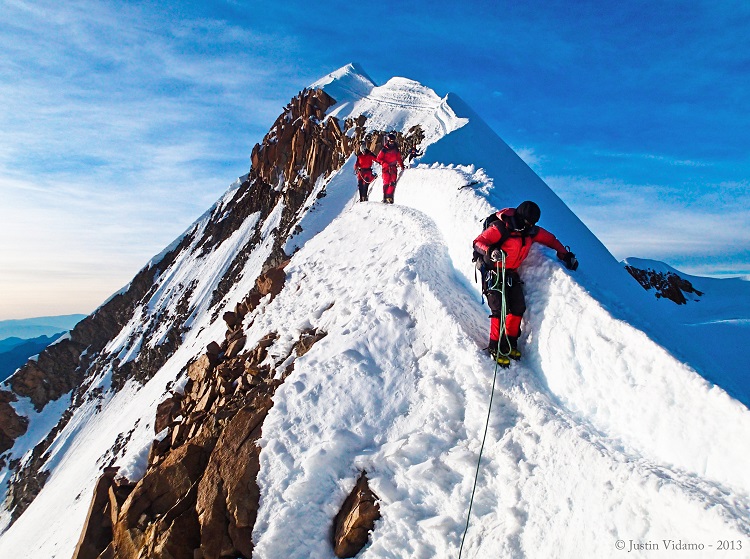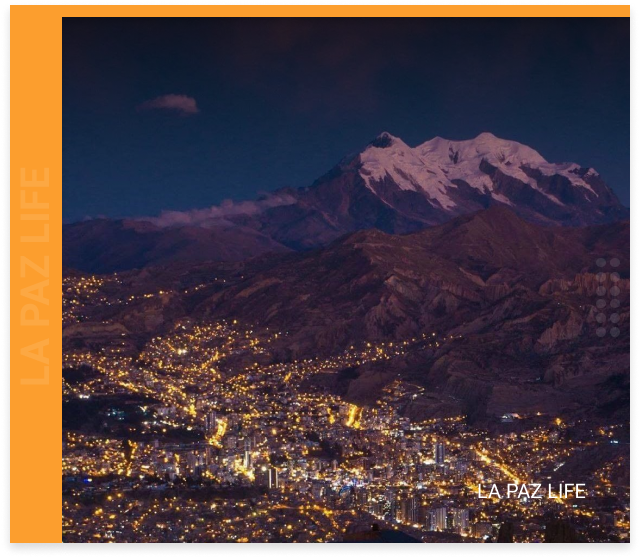Huayna Potosi Mountain
With its spectacular views, accessibility to beginner climbers and close proximity to La Paz, it’s easy to see why Huayna Potosi is the most popular mountain to climb in Bolivia.

Photo Credit: Justin Vidamo
Meaning “Thunderous Youth” in Aymara, the 6088m high mountain not only provides a breathtaking backdrop to La Paz’s urban center, but feeds the city’s largest hydroelectric power plant with its glacial water.
Adventurous spirits tackling Huayuna Potosi will be rewarded with stunning views over La Paz and Cordillera Real mountain range, making the climb one of the most memorable and rewarding things to do in Bolivia.
Climbing History
The first attempt to reach Huayna Potosi’s summit was made in 1877 by a group of six German climbers. Unfortunately due to lack of proper equipment and knowledge about the mountain’s terrain, four of the six climbers died at an altitude of around 5600m. The remaining two climbers were able to make their way back down the mountain to Zongo Pass, but died of exhaustion not long after their descent.
21 years later an expedition of Austrian climbers attempted to climb the mountain without success, having to retreat after 5 days spent at an altitude of 5990m.
Finally, in 1919, Germans Rudolf Dienst and Adolf Schulze made the first successful ascent of Huayna Potosí, climbing on the east face of the mountian (now referred to as the ‘normal route’) to reach the summit.
Difficulty

Photo Credit: Captp
Though often referred to as the “easiset 6000er in the world”, climbing Huayna Potosi is certainly no easy feat.
Considered by professionals to be a straight forward snow and ice climb, the mountain’s “Normal Route” entails an exposed ridge, some crevasses, and reaches an altitude of 6088m, making it a very difficult climb for those not adequately prepared.
It is highly recommendable to spend at least 3-6 days adjusting to the altitude in La Paz prior to climbing Huayna Potosi. People attempting the climb should also be healthy and physically fit.
Whilst experience is not required to climb Huayna Potosi, underestimating the mountain by not properly aclimatising or skipping the training day when you’re not an experienced climber, can not only prevent you from reaching the summit but can be life threatening.
La Paz Life Quick Tip:
As voted the best way to travel around Bolivia and Peru, we highly recommend choosing Bolivia Hop as your means of transport. Their safe, flexible and trustworthy service have proven to be the best way of getting the most out of your time in South America!
Climbing Routes

Photo Credit: Captp
The easiest and most straightforward way to Huayna Potosi’s summit is via the ‘Normal Route’, which is usually completed in two stages.
Starting at the Zongo Pass, climbers make the first 1-3 hour hike along clearly defined trails to High Camp (also known as Campo Argentino), which sits at around 5200m. Here there is the option to pitch a tent or stay in the refuge.
The next leg usually begins between midnight and 3am, taking around 3-6 hours, depending on fitness levels. An early start is advisable as, from 8 am onward, the snow becomes less stable, increasing the risk of an avalanche.
Just a few meters from High Camp, climbers are required to put on their crampons in order to climb the steep, but clearly visible passage leading to the summit. During this stage you will climb a 30 meter ice wall, jump over a crevasse or two as well as tackle a 45 degree wall of compressed snow.

Photo Credit: Captp
Upon reaching the top of the peak, climbers are rewarded with incredible views of the Altiplano, La Paz, Lake Titicaca and the entire Cordillera Real. For those quick enough, there is the chance to witness a truly spectacular sunrise. Finally, climbers will make the 3 hour descent back to base camp and onward to Laguna Zongo, where you can take a taxi or bus back to La Paz.
The climb from start to finish takes between 8 and 12 hours. For acclimatized and fit climbers, the whole experience from top to bottom can be completed in one go.
Other climbs on the east face of the mountain include the French Route, Bordaz Muñoz, and South-West . These are more technical climbs, requiring a higher skill level and advanced climbing knowledge.
Regardless of the route you choose, Huayna Potosi is a unique and memorable experience; a must do for avid adventurers and mountain climbers.
Accommodation
Camping at both Base Camp and High Camp is free. There is a Refugio at the end of Lake Zongo which offers accommodation and meals for Bs 80 ($12 US) per person, and a newly built refuge at High Camp called Casa de Guias – Anselme Baud.
During peak season booking is advisable and it should be noted that conditions are basic.
When to Climb
It is possible to climb Huayna Potosi all year round, however there are definitely more desirable times than others.
Winter (May to September) is the main climbing season as days are sunny and dry. Summer (November to March), though warmer, tends to be wet and cloudy, making climbs not only more dangerous and unpleasant, but decreases your chances of breathtaking views.
Snowfall can occur at any time during the season.
Getting To and From
Buses to the Zongo Pass depart from El Alto’s Plaza Ballivian daily. A minibus leaves at 5am and a larger bus at 6am. Get off at either Base Camp before Lake Zongo or 2km further on at the end of the lake where you will find the Refugio Huayna Potosi. Buses back to La Paz leave from the Zongo Pass in the early morning. There are no firm schedules so ask at Base Camp or the Refugio for more information.
Taxis from La Paz cost between Bs 200 ($30 US) and Bs 400 ($60 US), depending on how hard you haggle, and take 1.5 to 2 hours to reach Base Camp. The cheaper option is to take a taxi from Plaza Ballivian in El Alto which will cost around Bs 100 ($15 US). The journey takes 1.5 hours. To return to La Paz by taxi, ask the people at Base Camp or the Refugio to call you a taxi. The cost is around Bs 170 ($25 US).
Tour Companies

Photo Credit: Captp
Whilst it’s possible to climb Huayna Potosi without a guide, it is recommended to go with a tour if you are an inexperienced climber.
Most of the tour companies in La Paz offer 2 or 3 day tours, with the extra day used for training and aclimatiastion (critical for your chances of making the summit). The training period is spent practicing many different techniques on the ice including walking with crampons, climbing, abseiling and rescue techniques.
Tour prices vary between $150 – $300 US depending on the quality and length of the tour. Most companies will include the following in the tour price:
- private transport to and from Huayna Potosi
- qualified mountain guide
- equipment – climbing boots, crampons, ice axe, mountain jacket and trousers, harness, rope etc
- meals & accommodation (tent or refuge)
Please note that many of the guides have minimal English, however what they know is enough to guide climbers to the summit and back.
Reputable tour companies operating from La Paz include Climbing South America, Andean Ascents, Alititude6000 and Bolivian Mountain Guides.
Recommendations
- Spend a few days in and around La Paz before the climb to acclimatise
- Drink plenty of coca leaf tea in the mornings and lots of water throughout the climb
- Bring your own balaclava and gloves to go under the ones the tour provides for extra warmth
- Take paracetamol and altitude sickness medication with you
- Don’t go into the climb expecting 100% to reach summit as weather conditions can be unpredictable
Have you climbed Huayna Potosi mountain? Share your experiences in the comments below…















Let's Discuss...